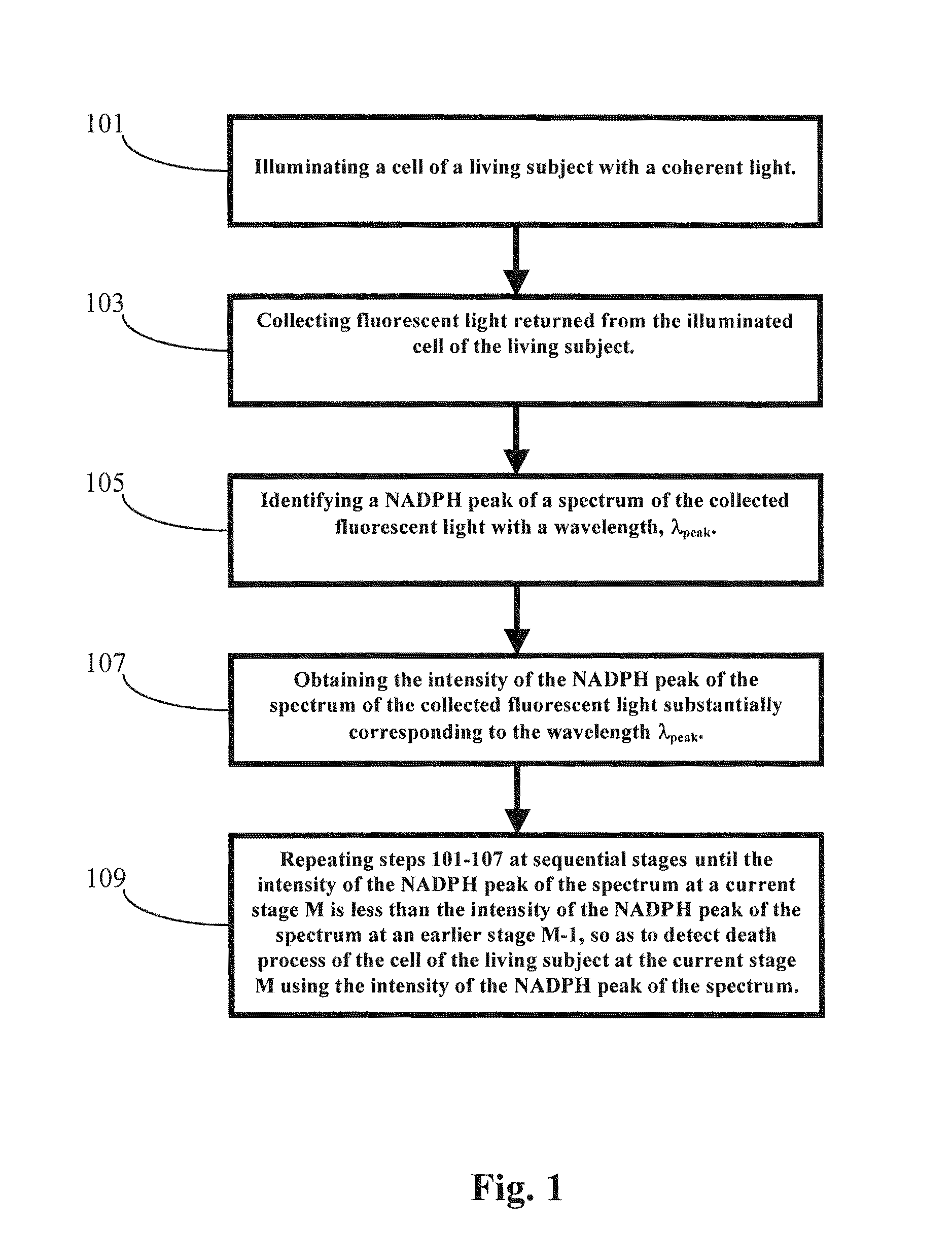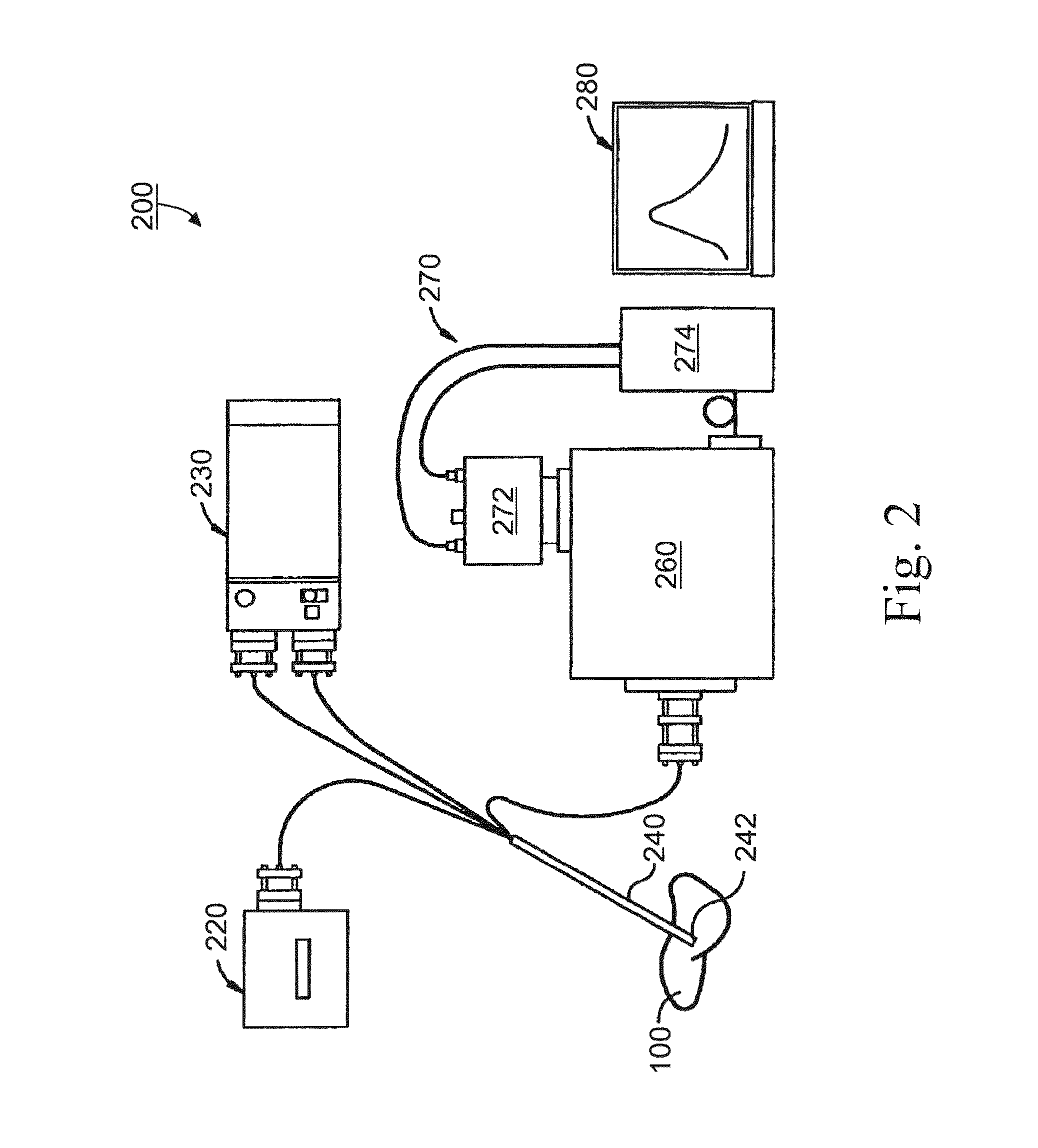Methods and Apparatus for Optical Spectroscopic Detection of Cell and Tissue Death
a cell and tissue death and optical spectroscopic technology, applied in the field of tissue diagnosis, can solve the problems of inability to perform real-time monitoring of the reaction, the complexity of histological procedures, and the inability to detect cell death
- Summary
- Abstract
- Description
- Claims
- Application Information
AI Technical Summary
Benefits of technology
Problems solved by technology
Method used
Image
Examples
example 1
Cell and / or Tissue Death Process Detection
[0075]In one embodiment of the present invention, a cell or tissue of a living subject was native at a first stage and was subject to hyperthermia and / or cisplatin for various periods of time at the sequential stages. The cells or tissues of the living subject to be diagnosed were human colon adenocarcinoma cells (SW480). The NAD(P)H peak of the spectrum of the returned fluorescent light from the cell or tissue of the living subject, which was illuminated by the coherent light with an incident wavelength around 337 nm, was substantially at a wavelength around 460 nm. The NAD(P)H peak wavelength λpeak did not shifted from 460 nm for the cell or tissue of the living subject at different stages. However, the corresponding intensity of the NAD(P)H peak of the returned fluorescent spectrum dropped dramatically when the cell or tissue of the living subject were subject to hyperthermia and / or cisplatin for various periods of time at the sequential ...
example 2
In Vitro Liver Tissue Discrimination
[0083]In one embodiment, liver samples, including normal and malignant liver tissues, were obtained from patients receiving a hepatic tumor resection and liver transplant. The liver samples were stored in a freezer at about − / 80° C. if not used immediately. The frozen liver samples were passively thawed at room temperature for at least 30 minutes prior to the optical spectral data collections.
[0084]Fluorescence emission characteristics of the normal and malignant liver tissues were characterized with excitation of a coherent light having a wavelength from about 250 nm to about 550 nm in about 10 nm increments using a spectrofluorometer, such as a LS-50 (Perkin Elmer Inc., Shelton, Conn.): The fluorescence spectra collected from a single sample were then used to form an excitation-emission matrix (hereinafter “EEM”). The liver samples of the normal and malignant liver tissues were dissected into about 5 mm thick slabs with a surface area larger tha...
example 3
In Vivo Liver Tumor Differentiation
[0091]In vitro studies, small-scale human clinical trials were conducted at Vanderbilt University Medical Center. The experimental protocol for the clinical trials was approved by Vanderbilt Institution Review Board. Hepatic tumor patients receiving hepatic tumor resection were selectively recruited by a surgeon, according to the tumor sites and patient's medical condition. Prior to the clinical trials, the experimental procedures were carefully explained to the participants, and written consent was obtained from each of them.
[0092]In the clinical studies, fluorescence and diffused reflectance spectra were acquired from perfused (i.e., prior resection) and non-perfused (i.e., post resection) liver tissue using the fiberoptic spectroscopic system described above. The fiber optical probe was sterilized, so it could be used in the operating field. Once the liver of the studied patient was exposed, perfused fluorescence and diffused reflectance spectra...
PUM
 Login to View More
Login to View More Abstract
Description
Claims
Application Information
 Login to View More
Login to View More - R&D
- Intellectual Property
- Life Sciences
- Materials
- Tech Scout
- Unparalleled Data Quality
- Higher Quality Content
- 60% Fewer Hallucinations
Browse by: Latest US Patents, China's latest patents, Technical Efficacy Thesaurus, Application Domain, Technology Topic, Popular Technical Reports.
© 2025 PatSnap. All rights reserved.Legal|Privacy policy|Modern Slavery Act Transparency Statement|Sitemap|About US| Contact US: help@patsnap.com



